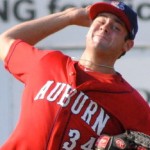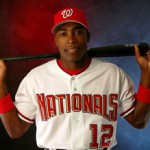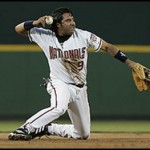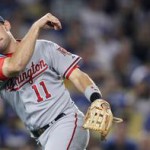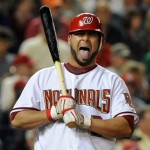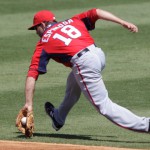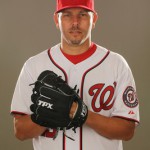
Is Maya going to be the latest Nats to Oblivion poster child? Photo Al Bello/Getty Images
Several years ago (November 2010) Mark Zuckerman posted a fascinating analysis he titled “From Nats to Oblivion.” It chronicled the astoundingly high number of players that the early incarnations of the Nats were using who, once the Nats released them, never again appeared on a MLB roster. I thought the analysis was so interesting that I kept up the same data and have been keeping it up-to-date with the whereabouts of Nats-to-Oblivion candidates ever since. So with apologies to Zuckerman for stealing his idea, here’s an interesting visit to the Nats darker past.
A large part of this post is borrowed from previous versions; click here for 2012’s version of this post. A few players from our near past have re-surfaced in the majors as of late and have been removed from this list where noted; if you see any others listed here in error please let me know. But this entire list is updated post 2013 season, with the minor league/foreign league/independent league movements of oblivion candidates chronicled.
It is nearly impossible for a team to field an entire year’s worth of players who will not fall into this “Oblivion” category. Every MLB team has guys playing out the string or near retirement, and every MLB team calls up guys through out the season from the minors who eventually show themselves as unable to compete on the MLB level and who never make it back. So a 0% oblivion measure isn’t a goal.
For your reminiscing pleasure, here is the summary data updated to the 2013 team:
- 2012: 24 position, 19 pitchers, 43 total. 5/43 = 11.6% candidate ratio
- 2011: 20 position, 24 pitchers, 44 total. 6/44 = 13.6% candidate ratio
- 2010: 20 position, 26 pitchers, 46 total. 12/46 = 26.0% never appeared again
- 2009: 25 position, 30 pitchers, 55 total. 9/55 = 16.3% never appeared again
- 2008: 25 position, 25 pitchers, 50 total. 8/50 = 16% never appeared again
- 2007: 21 position, 26 pitchers, 47 total. 12/47 = 25.5% never appeared again
- 2006: 28 position, 29 pitchers, 57 total. 20/57 = 35% never appeared again
- 2005: 30 position, 25 pitchers, 55 total. 16/55 = 29% never appeared again
Look at the 2006 season; 35% of the players who played for the team that year never played another Major League game. That’s still astounding to me. Read on for a detailed look back at some of the very bad players that have put in significant time for this team.
2013 (13 Candidates):
Total Players used: 23 position, 21 pitchers, 44 total. 13/44 = 29.5% candidate ratio right now. Real candidates list is just the top 5, so 5/44 = 11.36%.
Candidates
- Yunesky Maya; ML deal with Atlanta for 2014
- Chris Marrrero: ML deal with Baltimore for 2014
- Chad Tracy: still a FA; highly unlikely to get a major league deal after his awful 2013.
- Corey Brown: DFA’d, traded to Oakland
- Fernando Abad; DFA’d, traded to Oakland
Less likely “candidates” from the 2013 team:
- Danny Espinosa
- Jhonatan Solano
- Jeff Kobernus
- Zach Walters
- Eury Perez
- Sandy Leon
- Nathan Karns
- Erik Davis
The top 5 players are really the “candidates” out of the 2013 team. Every one of the guys in the lower section is on our 40-man roster, meaning they all likely see time this coming season. In fact, right now the odds are that at least a couple of these guys will make the opening day roster. So really the oblivion candidates here are just the top 5 guys, but we’ll track all 13 until they’re cleared off this list. Both the guys we traded to Oakland sit on their 40-man roster, but both seem in serious jeopardy of being DFA’d again at some point in the spring (especially Corey Brown, who is out of options).
Favorite Nats-to-Oblivion story: Yunesky Maya, who was Mike Rizzo‘s first foray into the Cuban exile market. Signed to a 4yr/$8M deal, he was given several shots at the majors and never could capitalize. He arrived in the US with a wide arsenal of pitches but not a lot of swing-and-miss talent, and he ended up basically being a AAA starter. He spent the last three seasons as Syracuse’s lead starter (getting 22, 28 and 24 starts there inbetween infrequent call-ups) and ended up with just one career MLB win for his $8M salary (making his one of the worst dollars-per-win contracts ever … even if it was “just” $8M). This whole paragraph is assuming that Maya never makes it back to the majors … but based on what he’s shown thus far combined with his advancing age, that seems like a likely end-result for the Cuban starter.
2012 (5 candidates)
Total Players used: 24 position, 19 pitchers, 43 total. 5/43 = 11.6% candidate ratio right now
Candidates
- Brad Lidge: Retired post 2012
-
Jesus Flores; signed ML deal with Los Angeles Dodgers for 2013, no MLB appearances
- Brett Carroll: signed ML deal w/ Pittsburgh for 2013, no MLB appearances
-
Ryan Perry: Wash AAA and AA 2013
- Carlos Maldonado: Wash AAA 2013
In the past 12 months, we’ve removed 3 players from this list (Izturas, Wang and Brown) who re-appeared on MLB rosters either here or elsewhere. I still think its possible that Flores could re-appear on an MLB roster at some point; catchers have a way of getting hurt and causing organizations to scramble. The rest face pretty long odds.
Favorite Nats-to-Oblivion story: Brad Lidge, who gave it one last shot and failed spectacularly. When you lose your stuff, its gone and gone fast. I’ll readily admit I thought the signing was a great one when it occurred but it just didn’t work out. I really hoped that Lidge would be a serviceable 7th inning guy and mentor to Drew Storen and Tyler Clippard, being one of the great closers of his day. It didn’t work out that way.
2011 (6 candidates)
Total Players used: 20 position, 24 pitchers, 44 total. 6/44 = 13.6% candidate ratio right now…
Candidates
- Ivan Rodriguez – retired after 2011
- Matt Stairs — retired after 2011
- Alex Cora — retired after 2011, now the General Manager of a Puerto Rican Winter League team.
- Cole Kimball — Nats 60-day DL in 2012, XST in 2013, DFA’d off 40-man roster.
- Brian Broderick — Stl AAA, waived now Nats AAA in 2012, AA in 2013
- Atahualpa Severino — Nats AAA, DFA’d off 40-man in 2012, KC AAA for 2013, signed ML deal with Atlanta for 2014 (thanks John C).
Changes in the last 12 months: none.
As with the 2012 candidates, I wouldn’t be surprised to see this list get lowered by one eventually; Severino seems like he could work his way back into a loogy situation for a club. Kimball’s DFA and Broderick’s pending MLFA status both make it seem like their chances of returning to the majors are slim.
Favorite Nats-to-Oblivion story: Matt Stairs: He made the 2011 roster despite having almost no defensive capabilities and, as it soon became evident, almost no remaining abilities at the plate. He somehow hung onto his roster spot until August 1st despite having just one extra base hit in 74 at-bats on the year. I remember one game in particular; we were at the stadium going against the hated Phillies and they left Roy Halladay in to attempt to finish a shutout with a 3-0 lead (Game was on 4/13/11). Nats rally, score 2 runs to make it 3-2. Stairs comes up pinch hitting for Jerry Hairston with guys on 1st and 2nd with one out; he promptly watches three straight fastballs go right down the middle of the plate without moving his bat. I’ve never been so p*ssed at a player at the ball-park. Ivan Rodriguez then promptly struck out on 3 pitches as well, looking strike 3 into the mitt and then arguing vehimently with the ump over the game-ending call which gave Halladay the complete game victory.
2010 (12 players)
Total Players used: 20 position, 26 pitchers, 46 total. 12/46 = 26.0% never appeared again
Players:
- Willy Taveras; played AAA for Col in 2011, retired prior to 2012, back with KC AAA 2013
- Kevin Mench; retired after 2010
- Jamie Burke; retired after 2010
- Luis Atilano: in CIN org, AAA in 2012, never signed for 2013
- Scott Olsen; in CWS org, AAA 2012, never signed for 2013
- JD Martin; in MIA org AAA 2012, in TB AAA 2013
- Tyler Walker; indy league 2011, never signed for 2012
- Jesse English; indy league 2011, 2012. Mexican League 2013
- Matt Chico; indy league 2012, never signed for 2013
- Joe Bisenius; in Mexico 2011-12, Atlanta AA/AAA for 2013
- Garrett Mock: Houston AAA 2012, AZ AAA for 2013
- Jason Bergmann: indy 2011, Col AAA 2012, Indy again in 2013, KC AA team.
Changes in last 12 months: none.
There’s more than a few guys here who are still hanging on to AAA jobs but not many of them are looking promising to break onto 40-man rosters and earn call-ups.
Favorite Nats-to-Oblivion story: Jamie Burke: The 2009 Nats were so thin at Catcher by the end of the season that we literally bought a spare catcher in Burke from Seattle so we could have some coverage at the end of the season. Burke re-signed on for 2010 and appeared in exactly one MLB game. He was released after the season and retired.
2009 (9 players)
Total Players used: 25 position, 30 pitchers, 55 total. 9/55 = 16.3% never appeared again
Players:
- Elijah Dukes: released and never picked up for 2010. Arrested in 2011, 2012, out of baseball.
-
Alex Cintron; playing in Mexico 2012, nothing in 2013
- Jorge Padilla; in SD org, AAA in 2012, nothing in 2013
-
Ron Villone, AAA all of 2010, 2011 playing indy ball, retired prior to 2012. He will appear on the 2015 Hall of Fame ballot and is currently the pitching coach of the High-A Chicago affilliate.
- Julian Tavarez; retired after getting DFA’d in July 2009
-
Zack Segovia; in Det org AA in 2012, Mexican league/Indy ball 2013
- Mike Hinckley: Tor org in 2011, retired prior to 2012
-
Steven Shell; KC org in 2011, retired prior to 2012
- Victor Garate; MIL org and Indy ball in 2012, Mexican league 2013
Changes in last 12 months: removed Kensing and Martis after they both resurfaced on MLB teams, meaning that they both went three full seasons inbetween MLB appearances. That’s why we track these guys for so long.
Favorite Nats-to-Oblivion story: Ron Villone, who proved that a crafty lefty with a halfway decent fastball can have a long career in this game. He had 63 appearances at age 39 for the 2009 Nats and got re-signed for 2010. He didn’t make the team though, labored in Syracuse the whole season and was released. Despite being 41 years old, he headed to Indy ball for one last shot but washed out after just a few outings in 2011.
It wouldn’t be a retrospective on poor Nats players if we didn’t briefly talk about Elijah Dukes though. I think its safe to assume that he’s the only guy on this list that has served more time in jail than has played in the minor leagues, attempting to get back to the show.
2008 (8 players)
Total Players used: 25 position, 25 pitchers, 50 total. 8/50 = 16% never appeared again
Players:
- Kory Casto; 2009 AAA, 2010 in Ariz AA, retired.
- Dmitri Young: some rehab in low minors 2009, retired.
- Rob Mackowiak: 2009: some indy, bounced around AAA, that’s it.
- Johnny Estrada; flat out quit after 2008
- Odalis Perez; refused his 2009 contract, never resigned
- Levale Speigner; 2009 in Florida’s AA/AAA, then 2010 in Seattle AAA. done.
- Ray King; retired after 2008
- Chris Schroder; 2009, 2010 bounced around AAA with Oakland, Fla.
Changes in last 12 months: none
Favorite Nats-to-Oblivion story: Odalis Perez, though I’m tempted to say either Mackowiak or Estrada, possibly the two worst FA signings of the whole Jim Bowden era (and that’s saying something). But nothing beats the Perez story. He was the Nats Opening Day Starter in 2008; hell he was the first guy to get a start in the Nationals Stadium. He pitched well; in 30 starts he was 7-12 with a 4.34 ERA and a 99 ERA+ for a god-awful team. But apparently he got really pissed when the team only offered him a non-guaranteed Minor League deal for 2009. So he held out, the Nats said “fine with us” and released him, and nobody else picked him up. And he never played another game. I’m not sure if that was a sign that he was just that bad (not one team wanted to even give an opening day starter a look the subsequent year?), or if there was some sort of MLB general manager omerta that conspired against him. Either way, Perez played again, not even in Winter Leagues as far as I could find. Sometimes a player has to swallow his pride, and Perez apparently could not.
2007 (12 players)
Total Players used: 21 position, 26 pitchers, 47 total. 12/47 = 25.5% never appeared again
Players:
- Nook Logan; indy league 2008, 2010.
- Robert Fick: Cut from the Padres in ST 2008, full year indy league 2009, retired.
- D’Angelo Jimenez: AAA all of 2008, 2009. Mexican league and Indy league 2010-2012
- Tony Batista: Wash AAA 2008, then released
- Michael Restovich: 2008 in Japan, AAA 2009-2011, retired
- Brandon Watson: AAA 2008-9, indy league 2011, retired.
- Mike Bacsik: 2008 AAA, 2011 indy league, now a broadcaster.
- Jason Simontacchi; 2008 indy league, 2010 again.
- John Patterson; cut in ST 2008, immediately signed w/ Texas but never played again.
- Ryan Wagner: AAA 2008-9, released and presumably retired.
- Arnie Munoz; went to mexican league, retired > 2010
- Chris Booker: AAA in 2008, then retired/released.
Changes in last 12 months: none
Favorite Nats-to-Oblivion story: Mike Bacsik, who was destined to be a career 4-A guy before Washington picked him up and gave him 20 starts in 2007. Bacsik was on his 6th minor league organization when he arrived in Syracuse and pitched his way up to the major leagues. He was overmatched badly; he had a 5.11 ERA and just a 3.4 K/9 rate. But he did get his moment in the headlines by giving up Barry Bonds‘ 756th career homer one night in San Francisco in August. Contrary to accusations on the topic, I do not believe Bacsik “served up” the homer. If you check the play index, Bonds hit the 7th pitch of the at-bat in a 3-2 count for that homer. Bacsik didn’t purposely give up a homer on the 7th pitch of an at-bat; he just ran out of pitches to show Bonds that weren’t going to get pulverized.
A quick comment though on John Patterson: I remember being absolutely shocked at his release in 2008’s spring training. He was cut on 3/20/08, right in the middle of Spring Training with no warning and having just thrown his Grapefruit innings. He was healthy, recovered from surgery, ready to be the ace of that staff and start showing off the potential that he showed in 2005 (you know, when he 4-hit the Dodgers with 13 punch outs and posted the best Game-Score performance in Nats history). He signed a ML deal with Texas after his release by the Nats, but he couldn’t answer the call and never appeared again, getting released in mid May. I guess his third arm surgery in 7 years just left him unable to compete at any level and he hung ’em up.
2006 (20 players)
Total Players used: 28 position, 29 pitchers, 57 total. 20/57 = 35% never appeared again
- Damian Jackson; dnp 2007, indy league 2008-9
- Bernie Castro: AAA all of 2007, 8 then retired.
- Alex Escobar: Wash minors 2007-8, then retired.
- Brandon Harper: Wash AAA all of 2007, then released/retired.
- Wiki Gonzalez: CWS AAA all of 2007, indy league 2008, retired.
- Henry Mateo: AAA or Indy league 2007-2009, mexican league from 2010-current 2013
- George Lombard: AAA 2007-9, some indy league, retired.
- Mike Vento: 2007 Wash AAA, indy league 2008, back with Syracuse 2009, retired.
- Melvin Dorta; various minor leagues 2007-2010, indy league 2011, retired.
- Luis Matos: AAA 2007, Mexican League 2008-2012. ? 2013
- Pedro Astacio; retired after 2006
- Felix Rodriguez: dnp 2007, indy league 2008-9, retired.
- Zach Day: AAA 2007, briefly A+ 2008, retired.
- Beltran Perez; wash minors AA/AAA 2007-8, released and never played again.
- Joey Eischen; released off of Washington and retired.
- Travis Hughes; AAA in 2007, played in Japan 2008, indy leagues 2009, 2011.
- Ryan Drese: various minor leagues 2007-8, indy league 2009-2010, Baltimore AAA 2011, released/retired.
- Kevin Gryboski: AAA 2007-2008, retired/released.
- Brett Campbell: Wash AA 2007, released/retired.
- Santiago Ramirez: Japan in 2007, Mexican league 2008, indy 2009, retired.
Changes in last 12 months: none
Favorite Nats-to-Oblivion story: Joey Eischen, who bounced around the league in his 20s before settling in Montreal and moving south with the team. He was known to be a “character” in the clubhouse and to give good quotes to reporters (google “Joey eischen quotes” and you’ll find some of his classics). By 2006 though the years had taken their toll on his shoulder; he had 19 walks in 14 2/3 innings through the end of May had blown his rotator cuff. The team put him on the 60 day D/L and called up one Bill Bray. Eischen never got off that D/L; he was released in the off-season and never played again. For 2013, he’s listed as the pitching coach of Colorado’s high-A Affiliate in Asheville.
2005 (16 players)
Total Players used: 30 position, 25 pitchers, 55 total. 16/55 = 29% never appeared again
Players:
- Carlos Baerga; retired after 2005
- Junior Spivey: bounced around AAA 2006-7, indy ball in 2009, retired.
- Tony Blanco; Nats minor leagues 2006-7, Colorado AA in 2008, in Japan from 2009-present.
- Wil Cordero; released mid 2005, signed on with the NY Mets but never made it out of AAA. Retired after 2005.
- Deivi Cruz; released after 2005, cut from St. Louis 2006 ST, played indy ball, retired.
- Jeffrey Hammonds; retired in June 2005 mid-season.
- J.J. Davis: Traded to Colorado as part of the Preston Wilson deal, sent to Colorado’s AAA, then released after the season and never played again.
- Rick Short; Granted FA after the 2005 season to play in Japan, played there til 2009.
- Kenny Kelly; AAA in 2006 and 2007, released and retired.
- Keith Osik; a backup catcher, got 4 ABs in 2005, released and retired.
- Tyrell Godwin; after just THREE MLB at-bats in 2005, spent all of 2006 and 2007 in AAA, released and retired.
- T.J. Tucker; released after 2005, tried one year of indy ball in 2008, retired.
- Joe Horgan; released after 2005, played one year of AAA with Florida, released, retired.
- Matt White; AAA in 2006-7, Japan 2007-8, tried indy ball in 2010, hung ’em up.
- C.J. Nitkowski; AAA in 2006, then went to Japan 2007-8, Korea 2009-10, back with the Mets AAA team in July 2012. Not signed for 2013
- Antonio Osuna: dnp in 2006, Mexican league 2007-9.
Changes in last 12 months: none
Favorite Nats-to-Oblivion story: Rick Short, who got his MLB debut at the age of 32, after 11 very long seasons in the minors with many different teams. He got a couple of call-ups in June and July to provide cover, and then played out the string after a Sept 1 roster expansion call-up. In that off-season, he returned to Japan (where he’d played one full season prior), and played four more years in the Japanese League and retired in 2009.
Though it merits talking about a couple other guys here. Tony Blanco; he was a rule-5 draftee who the Nats carried the whole of 2005 so they could keep his rights. He was awful; he had a .177 batting average as the 25th guy off the bench. In 2006 he couldn’t even cut it in AA and played most of the year in High-A. After 2007 the Nats summarily released him from their minor league organization altogether. He found his calling though; he signed on in Japan in 2009 at age 27 and continues to play there today. You have to wonder if he may very well earn another MLB shot.
Jeffrey Hammonds was well known to Washington baseball fans by virtue of his pedigree with our northern neighbors in Baltimore; he was a 1st round draft pick in 1992 out of Stanford, broke in with the MLB team the following year and was a role player on the powerhouse Baltimore teams of the mid 1990s. He bounced around the league afterwards though, signing on with the newly relocated Washington franchise for the 2005 debut season but he hung ’em up after a slow start here. He was only 34 when he retired.
